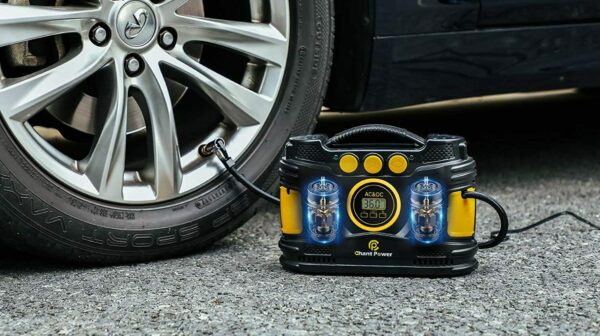If you get a flat tire while driving, it can throw off your whole day or even plan. Check the tire pressure before you leave, and if it’s not enough, pump up the tire. Tires can be inflated right away with the help of an air compressor. You should, however, know how to use a tire air compressor. In this article, we’ll go into detail about each step of the process.
Flat tires are a common problem for people who own cars, and an air compressor is cheaper, so why not use it? You’ll save both time and money by not having to go to the gas station.
Most importantly, the process is so simple that any car owner can do it on their own without help. It’s a good idea to keep a car in good shape so that you can drive safely and comfortably.

Table of Contents
How to fill tires with an air compressor
Our experts spent a lot of time making sure that this article had the best way to use the best air compressor to fill a tire, as well as some important tips and information to make sure that the process was safe and accurate. So let’s read the whole guide and take the next step toward keeping your car in good shape.
Before you learn how to use an air compressor to fill a tire with air, let’s take a look at the gears you’ll need.
Tool for Pumping Up Tires:
- A regulator
- Chuck a tire
- With 30 to 50 PSI, an air compressor
- Pressure gauge
Check your tire pressure.
Know how much air pressure needs to be in each tire. In general, each tire on a construction vehicle needs 100 pounds per square inch. The amount can change based on things like how many tires are on each axle, the weather, and how much weight is on each axle. Checking the user manual for the car can help you figure out how much air should be in the tires.
Don’t go by the PSI number on the tire, since it usually wants the most pressure. It will help you figure out what kind of air compressor you need for each tire.
The tire gauge is another part to check to make sure the right amount of compressed air has been added to the tire. Putting too much air in the tires can hurt how they drive and how long they last. On the other hand, not enough air will cause more friction, which will raise the temperature of the rubber.
If you can, try to fill up the tires when it’s cold outside. This will give you a more accurate reading. If you get somewhere and find a flat tire, wait half an hour so the tire can cool down.
Get the tire ready.
Most tires have a stem cap that goes on top of the valve stem. Take the cap off the stem of the valve and put it somewhere safe. When the cap was taken off, some of the air could come out right away. So it is best to get the compressor ready before taking off the cap.
Put the air compressor to work.
Since most people use an electric air compressor, we will move forward with this option. Plug the air compressor in so that it can gather air. Plug the air compressor into outlets with the right voltage. It’s best to use a portable air compressor that you can put near the flat tire.
So, how do you fill a tire with an air compressor? Start by connecting the air hose to the compressor and putting the coupler on the end. With this screw, the compressed air will be forced into the valve stem. Turn on the air compressor after securing the hose to the valve stem.
Depending on the kind of flat tire, it could take a while. Most air compressors have a gauge that helps the person who is using it add the right amount of air. Also, some inflators shut off automatically when the tire has the right amount of air. If you leave the running compressor alone for a long time, the tire could get too full.
Cut the hose off
While the compressor is running, check the tire pressure often. If you don’t have digital inflators to check the pressure and add too much air, push down on the tire gauge to let some of the air out. Once the tire has the right amount of air, take the hose off the air compressor. Don’t worry if you hear a hissing sound when you take off the hose. This is normal. The stem cap should then be put back on the valve.
Why should you put the right amount of pressure on the tire?
Maintaining the right tire pressure is the best way to save money and avoid problems in the long run. Even if you only use an air compressor for tires in your home garage, it’s a good investment.
Tires with the right amount of air pressure work better and make the ride more comfortable. So, it will lead to better control of the car as a whole. Having the right tire pressure is also important because it helps you get a good grip on the road.
On the other hand, when tires are over-inflated, they take up less space, which makes them less effective at absorbing shocks and bumps. In the end, you’ll have a bumpy ride, which will make repairs cost more. So it would be better if you put the right amount of air in the tire and drove in peace.
Can you drive a car with low tire pressure?
If you drive with low tire pressure, your car will use more gas, which is bad for it. Still, some people had to keep driving in these dangerous conditions because they had to.
If you have to drive in this kind of weather, remember the following:
- Don’t drive for a long time at a slow speed. When you drive faster or for a long distance, your tires will wear out.
- Don’t drive with too much weight, and it would be better if you could get rid of the extra weight. When the tire’s pressure is low, extra weight puts a lot of stress on it.
So, driving a car with low tire pressure is bad for both the driver and the car. If this happens to you, find the closest gas station so you can get the tire pumped up.

Advice on how to use an air compressor to fill tires
Many people make mistakes when they have flat tires or use an air compressor to pump up their tires. Remember the following tips to keep yourself safe:
- Don’t drive with low tire pressure if there is another way. It will not only wear out the tire, but it will also make the vehicle less effective.
- Don’t under or over-inflate the tire to make sure it works well and lasts a long time.
- If you don’t know enough or aren’t sure of yourself, you should call for help.
- Stick to the settings in the car’s manual.
- Use a pressure regulator to make sure that you have the right amount of compressed air.
- Check to see if the compressor, valve, power source, tire, and any other related parts work together.
- Safety should always come first.
How to Use a Tire Compressor: Frequently Asked Questions
Which PSI setting on the air compressor should be used to fill tires?
Set the regulator to the recommended pressure so you don’t have to worry about inflating the tires. Most cars and light trucks need 35 PSI in their tires. But it will be better if you check the tire or the door post of the car to make sure it meets the requirements.
How long does it take to fill a tire with an air compressor?
Usually, it depends on how much air is in the tires. If the pressure is low, around 5 or 6 psi, it won’t take more than 30 seconds for the air compressor to fill the tire.
How to use an air compressor at a gas station to fill a tire?
Pull up next to the car’s air pump and open the door. Set the desired psi rating on the spout. Take off the cap on the air valve, connect the spout to the air valve, and then start filling. Once you’re done, take off the spout and put on the cap for the air valve.
How to check if tires have enough air?
By letting go of the inflation lever, you can see how much air is in the tires. You can also use the tire gauge to find out how much air is in the tire.
Hope you know how to use an air compressor.
A car owner’s most important and common job is to pump up the tires. This is easy to do with an air compressor. One can do it themselves instead of going to the gas station and saving some money, but he needs to know how to use a tire air compressor.
The above step-by-step instructions will show you how to do the job perfectly. Plus, remember those important tips to avoid making mistakes and play like a pro.


